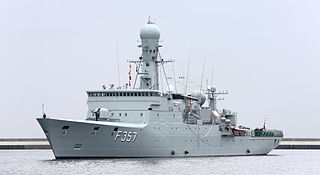
A frigate is a type of warship. In different eras, ships classified as frigates have had very varied roles and capabilities.

The Royal Danish Navy is the sea-based branch of the Danish Defence force. The RDN is mainly responsible for maritime defence and maintaining the sovereignty of Danish territorial waters. Other tasks include surveillance, search and rescue, icebreaking, oil spill recovery and prevention as well as contributions to international tasks and forces.
Twelve ships of the Royal Navy have borne the name HMS Thetis, named after the sea-nymph in Greek mythology:
A patrol boat is a relatively small naval vessel generally designed for coastal defence, border protection, immigration law-enforcement, search and rescue duties. There have been many designs for patrol boats. They may be operated by a nation's navy, coast guard, police force or customs and may be intended for marine or estuarine or river environments. They are commonly found engaged in various border protection roles, including anti-smuggling, anti-piracy, fisheries patrols, and immigration law enforcement. They are also often called upon to participate in rescue operations.

Future planning of the Royal Navy's capabilities is set through periodic Defence Reviews carried out by the British Government. The Royal Navy's role in the 2020s, and beyond, is outlined in the 2021 defence white paper, which was published on 22 March 2021. The white paper is one component of the Integrated Review of Security, Defence, Development and Foreign Policy, titled as Global Britain in a Competitive Age which was published on 16 March 2021.
Three ships of the Royal Navy have been named HMS Dumbarton Castle after Dumbarton Castle.
Six ships of the Royal Navy have been named HMS Amethyst, whilst another was planned:
River class may refer to:
Thetis is a sea nymph in Greek mythology.
The Royal Australian Navy, although a significant force in the Asia-Pacific region, is nonetheless classed as a medium-sized navy. Its fleet is based around two main types of surface combatant, with limited global deployment and air power capability. However, in 2009, a white paper, Defending Australia in the Asia Pacific Century: Force 2030, was produced by the Australian government which set out a programme of defence spending that will see significant improvements to the RAN's fleet and capabilities.

The Thetis-class ocean patrol vessels or ocean patrol frigates, also called Stanflex 3000, is a class of large patrol vessels built for the Royal Danish Navy. The class comprises four ships, all built and commissioned in the early 1990s. The ships' tasks are mainly maintenance of sovereignty, search and rescue, fishery inspection and support to local authorities. The operation areas are normally Greenland and the Faroe Islands, but the vessels also operate near Iceland on transit between Greenland and the Faroe Islands, and near Denmark.
Three ships of the Royal New Zealand Navy have been named HMNZS Hawea:

The Bung Tomo class is a class of three Indonesian multi role patrol corvettes. They were originally built for the Royal Brunei Navy and named Nakhoda Ragam-class corvettes but were ultimately bought by Indonesia and renamed. The class is named after Bung Tomo, a noted leader of Indonesia's independence movement.
Fridtjof Nansen (1861-1930) was a Norwegian explorer, scientist, diplomat, humanitarian and Nobel laureate.
Thetis class may refer to one of the following ship classes:
Twelve ships of the French Navy have borne the name Thétis in honour of nereid and sea nymph Thetis:
Many ships of the French Navy have borne the name Audacieux or Audacieuse, which means audacious in French, including:
This page is based on this
Wikipedia article Text is available under the
CC BY-SA 4.0 license; additional terms may apply.
Images, videos and audio are available under their respective licenses.




